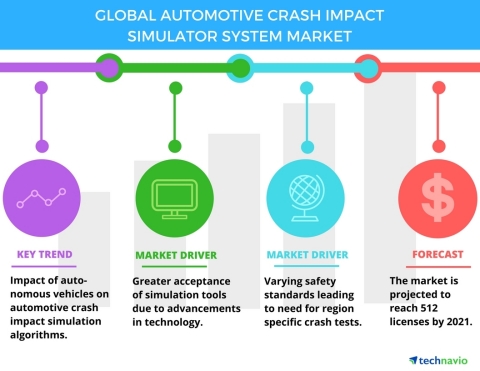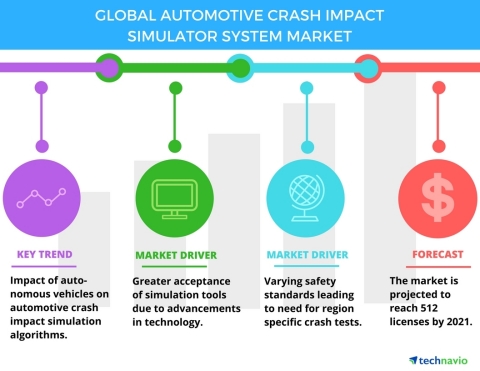LONDON--(BUSINESS WIRE)--Technavio market research analysts forecast the global automotive crash impact simulator system market to grow at a CAGR of close to 30% during the forecast period, according to their latest report.
The market study covers the present scenario and growth prospects of the global automotive crash impact simulator system market for 2017-2021. The report also lists the Americas, EMEA, and APAC as the three major geographical segments, of which EMEA dominated the market with a share of 60% in 2016.
This report is available at a USD 1,000 discount for a limited time only: View market snapshot before purchasing
Buy 1 Technavio report and get the second for 50% off. Buy 2 Technavio reports and get the third for free.
Technavio analysts highlight the following three market drivers that are contributing to the growth of the global automotive crash impact simulator system market:
- Crash and safety testing
- Advances in technology pave the way for greater acceptance of simulation tools
- Varying safety standards across geographies mandate region specific crash tests
Looking for more information on this market? Request a free sample report
Technavio’s sample reports are free of charge and contain multiple sections of the report including the market size and forecast, drivers, challenges, trends, and more.
Crash and safety testing
The number of new car launches has been increasing over the years, and the need for safety in vehicles is also on the rise. The maximum component of the cost of development of a vehicle is devoted to crash and safety testing. Though the designs are made after multiple simulations, the need for crash test remains vital.
Each automotive testing group has different goals like the governments want to check the safety standards, others want to learn about accidents themselves for reconstructing real-life accidents, and carmakers need it during product development to engineer safety systems to keep customers safe and to increase their sales volume.
“The simulated crash test plays a significant role during new product development as it gives designers the capability to test the designs and materials being used without having to physically build a prototype for testing. The inclusion of tire pressure monitor system and practice of educating drivers to change their driving habits have come about because of crash testing,” says Siddharth Jaiswal, a lead analyst at Technavio for automotive services research.
Advances in technology pave the way for greater acceptance of simulation tools
When automakers began to simulate the vehicle crash tests in the 1990s, it was a simple and coarse model and generally consisted of less than 1000 elements of basic components, such as bumpers. It usually took days to get results for a single component. Today, due to continuous advancements in computing resources, researchers have reached a stage where a full vehicle crash test, through simulation, involving millions of elements, can be completed in four to six weeks.
“In 2010, Altair Engineering, one of the leading providers of FEA software could mesh, assemble, and simulate a full-vehicle crash directly from OEM CAD data in just 24 hours. This kind of advancement in computing technologies and its ability to handle multiple cores in parallel will lead to wider acceptance of simulation tools shortly,” says Siddharth.
Varying safety standards across geographies mandate region specific crash tests
There are varying safety standards across various regions, which are required to be adhered by the OEM offerings. Due to this OEMs need to test their vehicles specific to the region they intend to serve. This implies that there is a need for crash test in each region the OEM serves. The increasing cost pressure forces the manufacturers to look for cost-cutting alternatives, though the increase in government regulations across various regions has forced the OEMs to concentrate on safety and emission standards in all the regions they serve
Manufacturing the vehicle by adhering to the highest safety standards can increase the cost of manufacturing. So, the OEMs are globalizing their products by designing cars as per global standards in order to maintain uniformity in their offerings worldwide and at the same time also ensuring that their vehicles adhere to the safety and emission standards persistent in a particular geography.
Browse Related Reports:
- Global Car Leasing Market 2017-2021
- Global Hydraulic Steering System Market 2017-2021
- Global Used Car Market 2017-2021
About Technavio
Technavio is a leading global technology research and advisory company. Their research and analysis focuses on emerging market trends and provides actionable insights to help businesses identify market opportunities and develop effective strategies to optimize their market positions.
With over 500 specialized analysts, Technavio’s report library consists of more than 10,000 reports and counting, covering 800 technologies, spanning across 50 countries. Their client base consists of enterprises of all sizes, including more than 100 Fortune 500 companies. This growing client base relies on Technavio’s comprehensive coverage, extensive research, and actionable market insights to identify opportunities in existing and potential markets and assess their competitive positions within changing market scenarios.
If you are interested in more information, please contact our media team at media@technavio.com.




